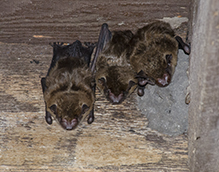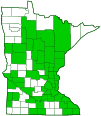Big Brown Bat
(Eptesicus fuscus)
Conservation • Description • Habitat • Ecology • Distribution • Taxonomy
Conservation Status |
|||
| IUCN Red List | LC - Least Concern |
||
| NatureServe | N5 - Secure S3 - Vulnerable |
||
| Minnesota | Special Concern Species in Greatest Conservation Need Big Brown Bat is one of several bat species susceptible to white nose syndrome (WNS). WNS causes high mortality in cave and mine dwelling bats. Big Brown Bats hibernate in caves but also in human dwellings and other constructions, and may be less vulnerable to the disease. |
||
Description
Big Brown Bat is a common, large, vesper bat. It occurs from southern Canada to the northernmost countries of South America, and in the Caribbean. There are twelve subspecies currently recognized. Four subspecies occur in North America north of Mexico, only one occurs in Minnesota. It is the most common bat in Minnesota. It is found in wooded areas near water sources in hollow trees, in trees with cavities, crevices, and loose bark; and in buildings, bridges, and other human constructions. In winter it hibernates in caves, tunnels, and buildings.
Big Brown Bat is the second largest bat in Minnesota. Adults of our subspecies (E. f. fuscus) are 4¼″ to 5″ (110 to 130 mm) in length, have a 12¾″ to 13¾″ (32.5 to 35 cm) wingspan, and weigh ½ to 1 ounce (15 to 26 g). Females are slightly larger than males. Like most bats, they have two mammae.
The fur (pelage) is long, glossy, lax, and uniformly dark brown on the upper side, paler on the underside. The membranes on the wings, tail, snout, and ears are blackish-brown. The color and large size is enough to distinguish Big Brown Bat from all other bat species in Minnesota.
The head is large, the nose is broad, the eyes are large, and the lips are fleshy. The ears are short, thick, erect, rounded at the tip, separated, inclined outward, and furred at the base. The fleshy projection at the base of each ear (tragus) is broad and blunt.
The wings are short and broad. The forearm length, a measurement significant to chiropterists (bat biologists), and included in all technical descriptions of bats, is 1¾″ to 2″ (46 to 51 mm).
The tail is 1½″ to 1⅞″ (38 to 47 mm) long and the tip projects slightly beyond the membrane between the thighs (uropatagium).
Size
Total length: 4¼″ to 5″ (110 to 130 mm)
Wingspan: 12¾″ to 13¾″ (32.5 to 35 cm)
Tail: 1½″ to 1⅞″ (38 to 47 mm)
Forearm length: 1¾″ to 2″ (46 to 51 mm)
Weight: ½ to 1 oz (15 to 26 g)
Sign
Similar Species
Habitat
Wooded areas; hollow trees; trees with cavities, crevices, and loose bark; buildings, bridges, and other human constructions; caves and tunnels
Ecology
Behavior
Lifespan
19 years
Life Cycle
Food
Insects, especially beetles
Disease Vector
Bats are important vectors of the rabies virus but rabid bats pose little threat to humans. They are passive, will not attack, and will not bite unless handled.
Distribution |
||
|
Sources Biodiversity occurrence data published by: Minnesota Biodiversity Atlas (accessed through the Minnesota Biodiversity Atlas Portal, bellatlas.umn.edu, 12/11/2025). Timm, R. M. 1975. Distribution, natural history, and parasites of mammals of Cook County, Minnesota. Occasional Papers, Bell Museum of Natural History, University of Minnesota 14:1–56. Hazard, Evan B. 1982. The Mammals of Minnesota. University of Minnesota Press, Minneapolis, Minnesota. 280 pp. The counties in light green lack modern records but have historic county or township specimens or records. |
|
| 12/11/2025 | ||
Occurrence |
||
Common |
||
Taxonomy
Class
Subclass
Theria
Infraclass
Placentalia (Placental Mammals)
Magnorder
Boreoeutheria
Superorder
Laurasiatheria (Ungulates, Carnivorans, and Allies)
Order
Chiroptera (Bats)
Suborder
Yangochiroptera
Superfamily
Vespertilionoidea
Family
Vespertilionidae (Evening Bats)
Subfamily
Vespertilioninae (Vesper Bats)
Tribe
Nycticeiini
Genus
Eptesicus (House Bats)
Subordinate Taxa
Big Brown Bat (Eptesicus fuscus bahamensis)
Big Brown Bat (Eptesicus fuscus bernardinus)
Big Brown Bat (Eptesicus fuscus dutertreus)
Big Brown Bat (Eptesicus fuscus fuscus) ![]()
Big Brown Bat (Eptesicus fuscus hispaniolae)
Big Brown Bat (Eptesicus fuscus lynni)
Big Brown Bat (Eptesicus fuscus miradorensis)
Big Brown Bat (Eptesicus fuscus osceola)
Big Brown Bat (Eptesicus fuscus pallidus)
Big Brown Bat (Eptesicus fuscus peninsulae)
Big Brown Bat (Eptesicus fuscus petersoni)
Big Brown Bat (Eptesicus fuscus wetmorei)
Synonyms
Common Names
Big Brown Bat
Glossary
Interfemoral membrane
In some mammals, the part of the patagium that extends between the legs and the tail; uropatagium.
Pelage
The coat of a mammal, consisting of fur, wool, or hair, and including a soft undercoat and stiff guard hairs.
Tragus
The fleshy projection on the inner side of the outer ear partially covering the ear canal.
Visitor Photos
Share your photo of this mammal.
This button not working for you?
Simply email us at info@MinnesotaSeasons.com.
Attach one or more photos and, if you like, a caption.
Christa Rittberg |
 |
Bats on the picnic shelter wall in Monson Lake State Park. |
MinnesotaSeasons.com Photos
|

Slideshows

Visitor Videos
Share your video of this mammal.
This button not working for you?
Simply email us at info@MinnesotaSeasons.com.
Attach a video, a YouTube link, or a cloud storage link.
Angela Garrett
Big Brown Bat 01
Sep 27, 2022
Other Videos
Big Brown Bat | CREATURE FEATURE #7
Marty Calabrese

Visitor Sightings
Report a sighting of this mammal.
This button not working for you?
Simply email us at info@MinnesotaSeasons.com.
Be sure to include a location.
Angela Garrett
11/11/2019
Location: Milaca, MN
Released, unharmed, from the Cheese Ball Bin after a 1 minute video for identification.
Minnesota Seasons Sightings






